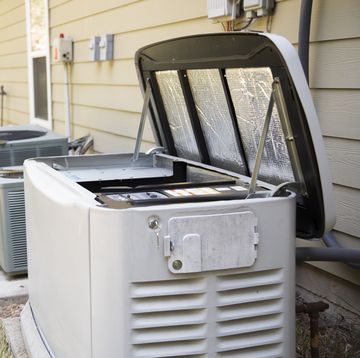When it comes to attainable home renovation projects you can DIY on your own, learning how to grout tile may feel out of your realm of expertise. Whether you consider yourself less-than-skilled at math and geometric layouts or don't trust your grout-mixing skills, it's easy to be intimated by a project that is this pro-level—and one that will have an obvious visual impact on your kitchen, bathroom, or laundry room. The good news? Learning how to grout tiles is actually easier than you think! Even better, we're here to help, providing you with the pro-vetted tips to absolutely nailing this kitchen renovation project.
Before we get started, a quick word: Laying your tiles is an entirely different process than grouting, so we've broken the two up into separate how-tos to make it easier to digest. Once you've laid your tiles and are happy with your chosen design and pattern, you're ready for the next step in the installation process: grouting (this should typically happen within 48 hours of installing your tile). We're laying out all the easy-to-follow steps below, including the materials you'll need and how to troubleshoot any mistakes you make. More of a visual learner? You can also watch the video above, courtesy of interior designer Whitney Jones, who has laid out all the steps in an easy-to-follow way. Or, better yet, do both to ensure you'll really nail the grouting process for the prettiest tiled surface possible.
What is Tile Grout?
Grout is the mixture that goes between the tiles, filling the gaps between each piece and lending an added layer of security to keep everything in its place. Grout can also add (and, in some instances, totally chance!) the appearance of your tile—a bold color can contrast your chosen tile and add another layer of visual interest, while a complimentary or subtle hue will allow your chosen tile to really sing.
Types of Grout
Most tiling projects call for cement-based grout, which is the most common form of residential grout. Grout also comes in epoxy and urethane varieties, though those are typically only used in commercial or industrial projects. Cement grout comes both premixed and powdered; premixed is sold in various-size tubs and is a convenient and easy choice for small-scale projects, while powdered grout will need to be mixed with water before use and is typically chosen for larger projects (like doing every bathroom in a home at one time). Additionally, tile grout can be found in both sanded and non-sanded varieties. A non-sanded grout is typically approved for use with tile joints up to 1/8-inch wide; sanded grout is the better option for anything larger than that, as it provides an added defense against cracks or shifting. Always check the installation instructions for your chosen tile before selecting a grout in case the manufacturer suggests a specific formulation.
How to Grout Tiles
Before starting your grout project, it's important to assemble the proper tools and materials. All of the below should be available at your local hardware store, but be sure to read the manufacturer's instructions for your chosen tile to see if they suggest you use a certain brand or hue of grout for best results.
You'll need:
- Grout (premixed or powdered)
- Painter's tape
- 2 to 3 small plastic buckets
- Rubber grout float
- Grout shaper (optional)
- Grout sponge
- 3 to 4 clean cloths
- Protective paper or plastic sheeting (as needed)
Instructions:
- If using powdered grout, mix it up according to the manufacturer's instructions. You should always add the powder to the water instead of the other way around and should be aiming for a thick, creamy texture (a bit like toothpaste). Don't mix too much grout at once, or you risk it drying out before you can use it.
- Cover any countertops or the surrounding area using protective paper or plastic sheeting where necessary.
- Using a rubber grout float, spread golf ball-sized lumps of grout over the tile surface in long, upward, and diagonal strokes. Be sure to hold the grout float at a 45-degree angle and work the grout deep into all the joints (which may necessitate going over them a few times). Work on less than a 10-foot area at the time to keep things fresh and manageable.
- Let the grout sit for about 15 minutes, then use a damp (but not soaking wet—if water is running down the face of the tiles, your sponge is too wet!) grout sponge to wipe away excess grout that's covering the face of the tiles. Keep a bucket of water nearby to rinse and squeeze out the sponge periodically so you're cleaning the surface as much as possible.
- When the grout has hardened slightly, use a grout shaper or your finger to neaten up the joints, aiming for a flat depth and smoothing out any regularity. If any gaps or holes appear, apply more grout with your fingertip. Sponge off any excess.
- Allow the grout to dry for several hours, preferably overnight. Polish the tiles with a clean, dry cloth, taking care to remove any film from the front of the tiles so they shine.
- Apply a grout sealer, if needed, according to the manufacturer's instructions.
How to Replace Tile Grout
Tiles actually rarely wear out — it's the grout that generally lets them down. If your grout is just looking a bit dingy, it can often be resurrected by a grout pen. However, if your grout is chipping or caving in, repairing the damage is often the best way to ensure your bathroom or kitchen continues to function (and look) good. Replacing grout can be an inexpensive way to freshen up the look of your bathroom or kitchen, but the project can vary in difficulty depending on the type of tile you have (smaller styles, like penny tile, will be much more difficult to fix than traditional 4 x 4 squares).
You'll Need:
- Old toothbrush
- Dishwashing soap
- Grout rake or removal tool
- Vacuum cleaner
- Supplies for grouting (see above)
- Vinegar and baking soda (as needed)
- Bleach (as needed)
- Mold and mildew remover (as needed)
Instructions:
- Start by cleaning the worn area with an old toothbrush and dishwashing liquid, paying extra attention to areas that may have excessive direct, mold, or mildew. If the dirt is stubborn, a paste of vinegar and baking soda can help alleviate it; if moldy, a mold and mildew remover or a solution of one-part bleach to eight-parts water can help.
- Starting at the top of a vertical joint, gently pull the grout removal tool or knife down the center of the grout line, working to remove the old grout to a depth of around 1/8 inch. You need enough space for the new grout to take hold, but don't want to go too deep. Repeat along the horizontal lines. Be careful not to dislodge tiles and try not to slip and scratch the tile surface.
- Use the narrow nozzle attachment on a vacuum cleaner to remove all dust and debris from the joints and surrounding area.
- Apply grout as instructed above.
Follow House Beautiful on Instagram.















